
Pulse surveys: how to get more insight with fewer questions
- 06 02 2023
- in
- by Monique van Geest

With pulse surveys, you increase the quality of your feedback data. This allows you to focus on increasing customer satisfaction. How does it work? We are happy to explain.
Anyone who takes customer satisfaction seriously knows how important customer feedback is. Only if you continuously measure what customers are (un)satisfied with you can get a good picture of potential areas for improvement. But with customers increasingly reluctant to fill in surveys, data quality is under pressure. This is bad news for customer experience managers.
More and more people are review tired. They are inundated - often at illogical times - with requests to give their opinion. And because they have become accustomed to online convenience, they only respond to survey requests when it requires little effort. This is why we at Insocial recommend using pulse surveys.
What is a pulse survey?
A pulse survey is a short survey in which you ask for feedback immediately after the action or customer contact in the same channel. By doing so, you bring focus: you ask some relevant questions at the right moment about that one touchpoint.
Popular for measuring employee satisfaction
Pulse surveys have become especially popular in recent years to measure employee satisfaction. More and more companies realise how important it is for employees to feel comfortable. This has a major impact on business results, but also on customer satisfaction, for example.
Comprehensive employee satisfaction surveys are usually conducted annually. This makes adjustment difficult. Companies want to measure the effect of improvement actions directly, thus keeping a finger on the pulse. That means: sending out surveys more often.
Also for customer satisfaction surveys
Now that pulse surveys are better known, they are increasingly used and for other purposes. For measuring customer satisfaction, for instance. Say you are going to improve your order form, you can use pulse surveys before and after the change to quickly measure the effect of the improvement.
What does the ideal pulse survey look like?
At Insocial, we have already deployed many pulse surveys to measure customer satisfaction. In terms of structure, we see the following as ideal:
- 4 to 5 questions in total
- Question 1 addresses the key performance indicator (KPI)
- This question has five (visual!) answer options
- The follow-up questions address the underlying drivers
- Respondents can give open feedback
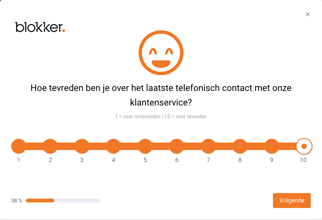
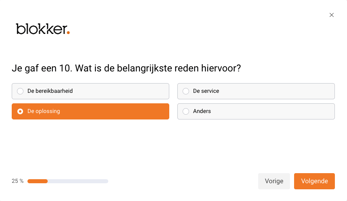
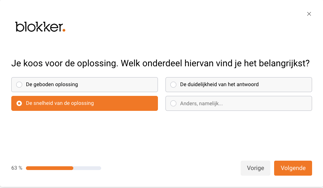
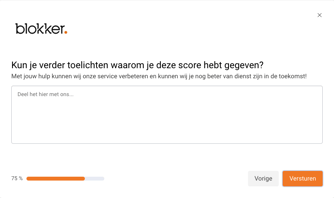
Few, but targeted questions
By focusing on one touchpoint, you get very targeted feedback. That way, you will know whether your change has the desired result. At the same time, a questionnaire with 4 to 5 questions has other advantages: because it requires little effort, respondents are more likely to complete your survey. You also clearly show your customers that you are improving your service and that you take their feedback seriously.
KPI-question
With your first question, you measure your KPI. If that is customer satisfaction, ask how satisfied your customer is with the product, service or specific moment in the customer journey. For this, you can use the Customer Satisfaction Score (CSAT), among others.
You simply ask the question: how satisfied are you with the product or service? Answering it should be easy. Therefore, work with five answer options, and let your customer click stars, smileys or thumbs up.
Drivers
The score on the KPI question says little if you don't know why your customer gives a particular score. That is why you then ask about the underlying driver(s). A high score shows what you especially need to retain. Low scores, on the other hand, provide insight into areas for improvement.
You can list a number of answer options that your customer can tick. The advantage of this is that you can then ask for a subdriver. But our advice is to always give your customer the option to fill in open-ended answers as well.
The value of open feedback
Open feedback provides the most valuable insights. Sometimes one answer puts you on the track of a concrete improvement action. Or you find out that the answer options you offer are not (quite) a good fit. So in an online survey, give customers the option to fill in a free field. Even after a phone call, you can ask customers questions about your service and ask them an open question. With voice-to-text, you can convert spoken passages into text that you can process
Processing open feedback
Processing open feedback can be a time-consuming, expensive job. But fortunately, the latest technology makes it easy. Using AI, you can let the computer analyse texts. In doing so, you use natural language processing (NLP).
By categorising the open feedback, you quickly get a picture of which products or topics many customers are reporting about. If you then use sentiment analysis to look for subjective information, you can detect emotions and opinions. This way, you quickly know where improvement actions are needed, and where you should change very little in particular.
Benefits of pulse surveys
At Insocial, we expect the popularity of pulse surveys for customer satisfaction research to rise even further. Because we see significant benefits. A pulse survey:
- Provides valuable feedback at one touchpoint
- Is easy to repeat after an improvement action
- Counters review fatigue and improves data quality
- Shows your customer that you take customer satisfaction seriously
- Continuously provides new insights to improve your services
How do you process all the data?
Sending out many (short) surveys does mean that you are constantly processing outcomes. Working with a single CX platform is therefore recommended. If you use a platform for collecting and processing feedback, different departments can work with it. This allows employees to better see which improvement actions are all being measured and who is working on what.
We have listed the other advantages of a single CX platform in a white paper.
Do you also want to use pulse surveys to improve your services?
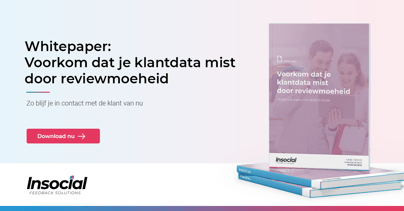
In our whitepaper you will read, among other things:
- What is the value of short pulse surveys
- Why pulse surveys work well against review fatigue
- How to further streamline feedback processing

